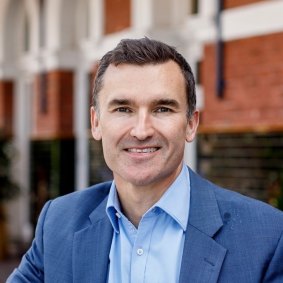- Analysis
- National
- WA
- Property market
As WA’s population cracks 3 million, what is being done to put a roof over our heads?
It has been more than a year since Planning and Housing Minister John Carey took over one of the toughest portfolios in the state.
With alarmingly inadequate levels of housing stock as the state’s population booms, runaway house prices, building companies collapsing at an alarming rate, homes left unfinished for years, record high rents and low vacancy rates, and homelessness doubling in a much publicised housing crisis, Carey has declared ad nauseam he is “pulling every lever” in a quest to put a roof over every West Australian’s head.

WA Housing Minister John Carey says he’s pulling every lever.Credit: Aresna Villanueva
WAtoday has analysed every policy announcement by the minister and consulted industry experts to figure out what has worked, what hasn’t, and what other levers should be pulled.
What has not worked
Keystart
When Carey took over in July 2023, he dropped the interest rate on loans issued by government-owned lender Keystart to 7.85 per cent.
Strategic Property Group managing director Trent Fleskens said if Keystart, which got its money cheaper than the big four banks, was serious about helping young people into the market it wouldn’t charge some of the highest interest rates in the country.
“This one is a no-brainer: stop profiting off young mortgage holders and drop your rate to compete with the big four,” he said.
“If the Keystart board is sitting around the table wondering why no one is using their product any more, it’s because it’s too expensive.”
It’s a sentiment echoed by UDIA WA chief Tanya Steinbeck, who said the high rate was a barrier for many prospective buyers. But she welcomed the July increase to the property price and income thresholds for Keystart loan eligibility.
“The thresholds are now much more reflective of the current market context. UDIA WA will continue to encourage an innovative approach to the products and supports available through Keystart such as offering more varied shared equity loan options, as well as more competitive interest rates.”
The new Urban Connect Plus loan product from Keystart to allow approved buyers to access a loan to support developers’ deposits for off-the-plan apartments was a step in the right direction but unlikely to be used for years given apartments are largely financially unviable for developers, except in the wealthier suburbs.
Social housing
WA was the rough-sleeper capital of the country at census in 2021, and according to Shelter WA, those numbers are getting worse.
With vulnerable West Australians struggling in the cost-of-living crisis, the state government has poured a record $3.2 billion into housing and homelessness measures and revamped calls for builders to help build 4000 social homes.

The number of homeless people in WA is rising. Credit: Joe Armao
Since 2021-2022, there have been 2500 social homes added, with the statewide waitlist at 20,331. The average wait time is 150 weeks, or nearly three years, compared to 136 weeks last year.
At the WA Liberal Party conference at the weekend, leader Libby Mettam said Labor had delivered an average of only 1.3 new social homes per month in its first seven years in power, while the population grew by hundreds of thousands.
“They have spent less on social housing than almost every other state,” she said.
However, that contradicted figures put to parliament in April, when South West MLC Jackie Jarvis said on average the government was adding about 75 social homes per month to the system and completing an average of 50 refurbishments per month.
Fleskens said the state wouldn’t be in this position if consecutive governments hadn’t left all the heavy lifting to the private rental market.
“It now costs the WA taxpayer 50 per cent more to fix the problem than it would have five years ago,” he said.
He added most builders shied away from working with government as many have gone broke being held to contracts they could not fulfil.
Carey said delivering 2500 new social homes was a “major win”, given the state was dealing with the tight construction market.
Land supply
The state government has opened up hundreds of hectares of land in Jandakot-Treeby, North Ballajura, Eglinton and Karnup for new housing estates in the hope it of delivering 15,000 new dwellings and hundreds of new social homes.
While the government described itself as pro-high density, curbing urban sprawl was not a priority during a housing crisis, Carey said.
Steinbeck said WA faced significant challenges around the availability of land for residential development, particularly as demand for housing rose.

As the population grows, so does the sprawl. Credit: Ross Swanborough
“Recent trends indicate that stock levels in the greenfield market are being rapidly depleted, and the available inventory is now at critically low levels putting upwards pressure on vacant land prices,” she said.
Housing diversity pipeline
In August, the state government tipped $17 million into expanding its Housing Diversity Pipeline program to allow developers to propose sites for the delivery of new homes on government owned “lazy land”. It hoped to allow the construction of 1700 new apartments.
Opposition housing spokesman Steve Martin claimed the policy was on life support.
“Industry knows the program is a dud, with only one of the 12 original sites earmarked for development under the HDP actually progressing,” he said.
However, Fleskens said the pipeline was a good example of the state government trying to turn over every rock to add more supply.
“To the extent the market allows it, these programs at least give every opportunity to flush out further housing supply opportunities than would otherwise have been created directly by DevelopmentWA,” he said.
Carey said Perth clearly needed more medium to high-density infill.
“I’ve made it clear that I want more infill, medium to high-density projects, but the reality is that given the market failure at the moment when it comes to more affordable, medium to high-density projects, the state is having to take a stronger role to facilitate that,” he said.
“There’s no conspiracy as peddled by the Liberal Party, that we just want density in the western suburbs. Reality is that is where it’s only viable because of high land value and of the location.”
What has worked
Slashing red tape
The state government has been reducing red tape and wresting power over planning decisions from local governments with a suite of measures including the permanent significant development pathway introduced for projects more than $20 million in Greater Perth.
Fleskens praised the move to help major projects minimise red tape and avoid NIMBY, activist councils.
“Increasing quality of the DAP panellists and scope for application eligibility provides more certainty to developers to avoid incompetent LGA councils,” he said.
But a policy backflip came when the state government abandoned its medium density code just 20 days from its planned introduction last year.
It would have encouraged infill development and mandated more trees and gardens, more attractive streetscapes and better designed homes with bigger rooms, better ventilation and natural light.
Its deferral raised concerns about the proliferation of largely treeless housing estates on Perth’s urban fringe.
However, the move was hailed as a win for housing affordability by property lobby groups the UDIA and Property Council, which had called on the government to remove or modify the code.
Fleskens applauded the decision, and said the code would have had a negative impact on supply and led to increased housing costs.
The $80 million Infrastructure Development Fund provided funding assistance to address up-front costs associated with connecting water, electricity and sewerage infrastructure, which have otherwise constrained development and impacted the viability of infill housing projects.
Treasurer Rita Saffioti said since the establishment of the fund, 79 apartment projects have been supported by the state government, with 5400 new apartments delivered.
One-percenters
WAtoday analysed the following policies as one-percenters; they have been nominally helpful in boosting housing supply.
These include the $10,000 incentive for Airbnb property owners to rent their properties to long-term tenants and the $5000 carrot to convert vacant properties into long-term rental homes.
WA homeowners will also be able to build a granny flat in their backyard without battling lengthy council approval processes.
Steinbeck said the granny flat exemptions were an excellent initiative, and had resulted in a significant uptake in people building a granny flat in their yard.
“A good example of how removing unnecessary red tape can facilitate more housing choice for West Australians,” she said.
Carey said 316 properties were returned to the rental market through the incentive scheme.
“The opposition said it wouldn’t work, but ultimately it’s the cumulative effect of those measures, and we shouldn’t mock those efforts because it is putting families in homes,” he said.
Levers that could – and should – be pulled
There have been widespread calls for the state government to waive stamp duty for first homebuyers and downsizers.
Mettam will take the party’s policy to raise the stamp duty exemption threshold to $550,000 and provide concessions for homes up to $700,000 to the next election.
“Stamp duty is an unproductive tax that stops people from buying – and from selling – a home,” she said.

WA Planning Minister John Carey.
There have also been industry calls to remove the foreign buyers surcharge to kickstart apartment development.
Limnios Property Group managing director James Limnios said it was a simple but effective way to boost apartments.
“Currently figures indicate that overseas buyers only account for around 1 per cent of residential sales in Perth and the WA budget papers indicate that the foreign buyers surcharge raises about $30 million per annum which is a minuscule amount in terms of the overall state budget,” he said.
Ray White chief economist Nerida Conisbee said government policy could change house prices.
“Easing up of planning controls can lower the cost of housing while policies that put more money in people’s hands can increase them,” she said.
“First home buyer incentives are particularly successful in getting more first home buyers into the market but, as a Productivity Commission report has shown, also drives up prices at cheaper price points.”
Carey said there was no one silver bullet to address the unprecedented housing challenges.
“There are promising signs from all the measures that we’ve introduced,” he said.
“We’ve seen the highest number of housing completions in six years (17,659), the strongest quarter of commencements since the 2022 December quarter and on top of that, we’ve seen now green shoots in the rental market with the vacancy rate increasing from 0.6 per cent to 1.6 per cent.
“So these are giving me confidence that the measures as a cumulative effect, are having an impact.”
Carey declined to be drawn on what policy measures he would take to the next election.
“There’s not a moment in time where we draw a line in the sand and say, ‘we’re done’,” he said.
Start the day with a summary of the day’s most important and interesting stories, analysis and insights. Sign up for our Morning Edition newsletter.